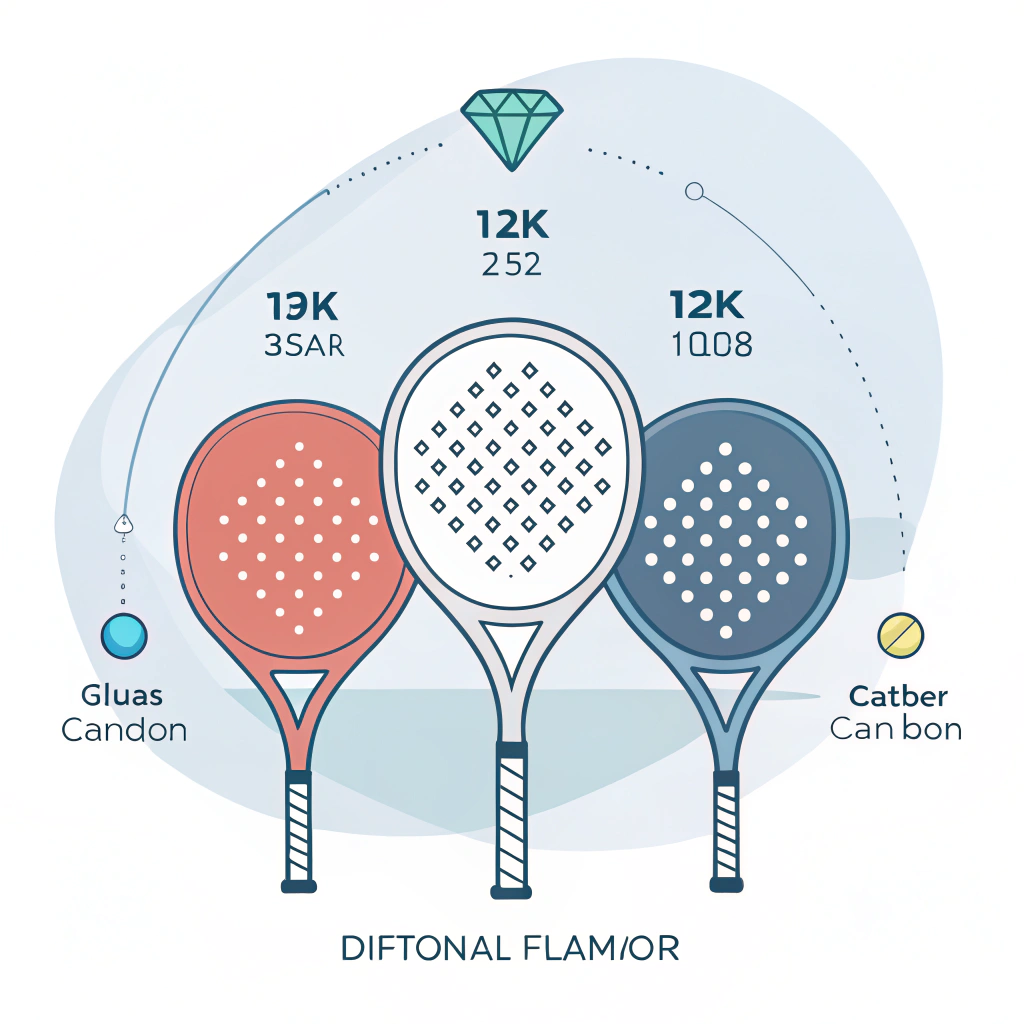Padel rackets are a critical investment, and choosing the right one largely depends on a careful balance of performance, durability, and customization. In a nutshell, selecting the ideal padel racket means comparing different materials, designs, and production techniques to ensure they match the needs of your players and market, while also aligning with your cost-effectiveness and branding requirements.
In today's competitive sports equipment market, club managers, equipment distributors, and retail buyers face a complex decision when selecting padel rackets. The choice goes beyond aesthetics—padel equipment1 must deliver high performance, exceptional durability, and the flexibility to meet varied customer preferences. This article explores the key elements that guide the selection process, focusing on material differences such as glass fiber, 3K, 12K, and 18K carbon fiber2, as well as design types including Diamond, Round, and Teardrop.
When evaluating different racket models, several critical factors come into play:
- Material Composition: The material not only impacts the racket’s weight but also affects its stiffness, durability, and overall feel. For B2B buyers, slight changes in composition from glass fiber to various carbon fiber grades (3K, 12K, 18K) can mean significant performance differences and longevity.
- Racket Design: The shape and balance of the racket—whether Diamond, Round, or Teardrop—play a vital role. Each design caters to different player skills and styles. For instance, a Diamond shape might offer power, while a Round shape can enhance control.
- Customization Options3: A crucial advantage is the ability to customize not only the shapes and colors but also additional elements like hand grips and logo placements. This flexibility allows your brand to stand out and cater specifically to your clientele.
- Cost-effectiveness: Balancing premium features with budget constraints is essential. The production techniques used, such as advanced carbon fiber lay-ups, significantly impact cost, and these differences must be evaluated closely.
- Performance Metrics: Durability tests, impact resistance, and vibration dampening are quantitative factors that underline performance. These metrics help ensure that the racket not only fits a specific player’s style but also withstands rigorous use.
For many industry professionals, the ideal padel racket is defined by the intricate balance between innovative materials and design precision. Here, we offer a multi-dimensional comparison across several key attributes.
Different materials have distinct advantages:
| Material | Weight | Stiffness | Durability | Cost-effectiveness | Best for |
|---|---|---|---|---|---|
| Glass Fiber | Moderate | Low | Satisfactory | Budget-friendly | Beginners, casual play |
| 3K Carbon Fiber | Light | Moderate | High | Mid-range | Intermediate players |
| 12K Carbon Fiber | Very Light | High | Excellent | Premium | Advanced players, power play |
| 18K Carbon Fiber | Ultra-Light | Very High | Best durability | High-end | Professional level |
This table helps visualize the performance trade-offs for each material option, ensuring that your selection process is both data-driven and aligned with your business needs.
The design of a padel racket shapes its performance characteristics. Below is an overview of the three primary designs:
-
Diamond Racket:
- Offers a forward weight distribution which is ideal for generating power in offensive play.
- Suited for aggressive players who require rapid, strong impact during smashes.
-
Round Racket:
- Features a balanced center of gravity that maximizes control and ease of maneuverability.
- Recommended for beginners or defensive play where precision serves better than power.
-
Teardrop Racket:
- Combines elements of both power and control with a slightly off-center weight distribution.
- Offers flexibility that appeals to mid-level players looking to adapt to varied playing styles.
By understanding these designs, B2B buyers can better match rackets to their target market. For instance, a club hosting competitive play might favor the Diamond shape for its power benefits, while a community center may lean toward the Round design for broader accessibility.
Customization is an essential criterion in the modern B2B procurement landscape. With advancements in manufacturing and digital printing, companies like NEX Padel provide high levels of customization that allow buyers to create distinctive product lines. Consider these aspects:
- Shape Customization: Besides the standard Diamond, Round, and Teardrop, fully customized shapes can be crafted to match specific player requirements or brand identities.
- Color and Print Options: Custom colors and printing options enable retailers to align product aesthetics with their brand image.
- Accessory Branding: Options to customize hand grips and grip covers offer additional branding opportunities, ensuring that every detail enhances the customer’s experience.
- Logos and Personalization: Product personalization through logo placement not only adds a premium feel but also drives brand recognition.
The ability to tailor each racket element helps bridge the gap between off-the-shelf products and bespoke market demands, ensuring that your investment is uniquely positioned to meet both performance and branding goals.
As experienced B2B professionals know, procurement is not just about acquiring equipment—it’s about strategic investments that enhance operational efficiency and player satisfaction. Here are several factors you should consider:
- Player Demographics and Skill Levels: Analyze your target clientele's typical playing styles. For instance, professional clubs require materials that withstand higher stress, whereas community clubs might prefer cost-effective options.
- Usage Frequency and Durability Requirements: Rackets used in intensive training sessions or tournament settings need higher durability and precise material grading.
- Market Positioning and Pricing Strategy: Premium clubs can justify higher investments in advanced materials like 18K carbon fiber, while broader market strategies might favor the balance of cost and performance seen in 3K or 12K options.
- **After-Sales Service and Production Lead Time4: Quick prototyping and timely delivery, as provided by manufacturers like NEX Padel, are critical to maintaining supply chain agility and market responsiveness.
Consider a decision matrix5 that quantifies these criteria. For example:
| Criteria | Importance (1-5) | Weighting (Overall Score) |
|---|---|---|
| Material Durability | 5 | 25% |
| Player Performance Enhancement | 5 | 25% |
| Customization Flexibility | 4 | 20% |
| Cost-effectiveness | 4 | 15% |
| Delivery and Production Speed | 3 | 15% |
Using this table, B2B buyers can score different models and make decisions that best fit their operational needs.
Recent market trends show a growing demand for high-performance padel rackets that combine innovative materials with customizable designs. Industry reports indicate that clubs prioritizing advanced technology—such as precision carbon fiber formulations—see higher player satisfaction and improved game performance. Additionally, sports equipment distributors are increasingly emphasizing customization as a unique selling proposition in competitive markets.
Furthermore, specific performance tests have demonstrated that rackets with 12K carbon fiber offer an outstanding balance between lightness and durability, making them ideal for competitive play. Meanwhile, the adaptability of design choices like the Teardrop format appeals to a broader market segment by offering both control and power.
As a leading manufacturer, NEX Padel leverages cutting-edge production techniques—ensuring strict quality control and quick turnaround times. This approach not only meets the demands of high-performance play but also provides the customization flexibility necessary for B2B procurement success.
In summary, the selection process for padel rackets in a B2B context should be viewed through a multi-faceted lens. Here are the key takeaways:
- Assess the material quality and composition against your expected usage scenarios.
- Evaluate the racket design (Diamond, Round, Teardrop) in relation to player demographics and typical playing styles.
- Factor in the significance of customization options that can enhance your product's market differentiation.
- Utilize a detailed decision matrix to balance performance, cost, and production lead time.
- Rely on data-backed industry trends and performance statistics to guide your long-term investment strategies.
By following this structured approach, you can confidently select padel rackets that not only drive player performance but also enhance brand value and operational efficiency.
Q: What factors should I consider when selecting a padel racket?
A: Evaluate the material composition, performance metrics, and customization options, along with cost-effectiveness and specific player needs to ensure that the padel racket aligns with both performance and business requirements.
Q: How do different carbon fiber grades affect padel racket performance?
A: Different carbon fiber grades, such as 3K, 12K, and 18K, influence the racket's stiffness, weight, and durability. Higher grades typically mean a lighter racket with greater stiffness and enhanced durability, which is suitable for advanced players and competitive settings.
Q: Are there customization options available for padel rackets?
A: Yes, customization options include tailoring the racket’s shape, color, printing, and additional accessories like hand grips. These features allow businesses to create exclusive products that align with specific brand identities and performance demands.
-
Padel equipment: Click to read more about the full spectrum of padel gear, its industry trends, and how performance attributes align with market needs, helping you make informed B2B procurement decisions. ↩ ↩
-
18K carbon fiber: Click to explore detailed insights on carbon fiber grades, including how 18K compares to lower grades in performance, durability, and cost-effectiveness for high-end sporting equipment. ↩ ↩
-
Customization Options: Click to understand how tailored product features and custom branding can provide a competitive edge, ensuring that your offerings precisely match client requirements and market trends. ↩ ↩
-
Production Lead Time: Click to delve into the logistics and management of production lead times, highlighting their impact on supply chain efficiency and overall business responsiveness. ↩ ↩
-
Decision matrix: Click to learn about constructing and utilizing a decision matrix for balancing multiple performance and cost-related factors in B2B purchasing strategies. ↩ ↩







